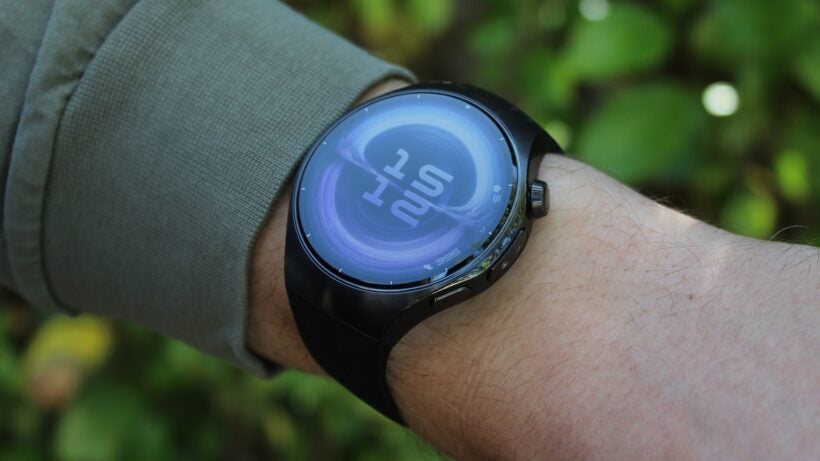Verdict
Huawei’s latest flagship smartwatch doubles down on exquisite design and a deep suite of native health features, spearheaded by the new X-Tap sensor. The Watch 5 is a testament to the brand's hardware prowess, boasting a stunning screen and impressive battery life. However, its brilliance is still dimmed by a limited app ecosystem and some quirks in its advanced health tracking. It's a highly capable fitness and health tracker in a premium watch's body, but one that continues to ask for more compromises than competitors.
Pros
- Premium design and build quality
- Bright and crisp LTPO display
- Superb AOD battery life
Cons
- Limited app ecosystem remains
- Not top-level workout HR accuracy
- X-Tap sensor feels more novel than essential
Two years on from its last flagship series, and following last year’s more sport-focused Watch GT 5 duo, the Huawei Watch 5 arrives with considerable expectation.
It lands as Huawei’s premier ‘classic’ smartwatch, designed to showcase the pinnacle of its design language, only receiving mild tweaks for this generation, and a new wave of health technology. This time, that latter mission is spearheaded by an ‘X-Tap’ health sensor on the side of the case.
For all the intrigue a new generation brings, though, the Watch 5 embodies a familiar narrative for Huawei: the hardware is gleaming, but the same can’t always be said for its handling of ecosystem challenges and truly valuable insights. Below is our full review.
Price, availability, and versions
The Huawei Watch 5 launches at £399, with three titanium versions (purple, silver, and brown) and a black 316L stainless steel model (which I tested) available to pick from. This is a premium price point, and, while it’s happily unchanged from the Watch 4 in this regard, it remains firmly in the territory of established giants.
Its key competition is the Apple Watch Series 10 (itself likely due for a Series 11 refresh around September) for iOS users, while Android users have the rumored Samsung Galaxy Watch 8 series (expected this summer) and Google Pixel Watch 4 also likely on the horizon.
However, while it shares a price bracket with these full-fat smartwatches, the Huawei Watch 5, as we’ll explore, operates as a very different kind of wearable. Its strengths and weaknesses carve out a unique, if somewhat niche, position in this fiercely competitive market.
As ever, it’s also not officially available in the US due to the ongoing sale/import ban.
Design: Still Huawei’s strong suit (with a few quirks)

If there’s one area Huawei consistently excels, it’s in crafting smartwatches that feel and look exquisite. The same is true again with the Watch 5; it’s not a stretch to say it’s one of the best-looking classic-style smartwatches I’ve ever had on my wrist.
More spherical sapphire glass is one change from the Watch 4, with the 316L stainless steel (though heavier than titanium editions) giving it a premium-feeling heft and polish. This does make it a bit harder to wear during exercise than a classic sports watch, which is to be expected.
Yet, unlike most stainless steel cases smartwatches I’ve tested in the last few years, I was pleasantly surprised by the weight distribution; the Watch 5 isn’t one I was dying to get off my wrist after dragging it around on a weekend long run.
The slimmed-down bezels are another tangible improvement, pushing the screen-to-body ratio to an impressive 80% on this 46mm model, according to the brand. It gives even more room for the LTPO display to shine. It’s sharp, vibrant, and capable of hitting a very bright 3000 nits. For reference, that’s on par with a device like the Apple Watch Ultra 2.

On reflection
This should make it a champion in outdoor conditions, but the automatic brightness is a bit conservative. Even under the harsh glare of direct sunlight, the Watch 5 rarely wanted to go beyond 40-50% brightness, forcing me to leave it cranked up (to the detriment of battery life) to see my real-time workout stats or notifications properly.
This wouldn’t be a problem with other watches, but it is a particular issue with the Watch 5 due to the display glass being incredibly reflective. Seriously, this is the most mirrored smartwatch display I’ve ever tested, and, as a result, there’s a slight misalignment with the auto-brightness feature.
In controlled lighting, it’s naturally less of an issue—and even its outdoor reflection is a minor blotch on what’s otherwise a pretty difficult design to fault. This is as good-looking as health-focused smartwatches get, and it feels a step ahead of what else is offered at this price point.
I’ll also note the X-Tap sensor here, though I’ll analyze its actual functionality below. On the Watch 5’s black case, the look of this extra sensor integrates fairly well, and you quickly forget about it during wear since it doesn’t just stand out any more than a typical side button.
However, I suspect it might stand out much more on lighter-coloured titanium models. Whether you can live with that look, as ever, is entirely personal.
Huawei’s X-Tap health play

Huawei is pinning much of its innovation narrative for the Watch 5 on the new ‘multi-sensing X-Tap’, which forms part of a redesigned TruSense System.
This is an additional sensor array on the side of the case that’s distinct from the main optical sensors on the underside, incorporating ECG, PPG, and tactile sensors. The idea is to unlock the fingertip’s thinner skin and denser vascularity to improve the accuracy and speed of health measurements, and then combine the findings with the underside sensor.
Functionally, X-Tap allows for an impressively fast sub-10-second SpO2 reading. It also provides a one-touch (well, a three-second hold) activation for an improved Health Glance—its 60-second snapshot of nine vital signs that now includes Heart Rate Variability (HRV) and a respiratory overview if you deliver a couple of coughs in the watch mic’s general direction.

Finger off the pulse
While it’s technically interesting and neat that Huawei is exploring novel ways to capture data, my core feeling is that it feels more like a solution in search of a widespread user problem. Realistically, I don’t think many people are clamouring to actively place their finger on a side sensor for routine health checks. Is a slightly faster manual SpO2 reading or a more engaged Health Glance a compelling enough reason to buy this watch? I’m not convinced, despite the tech being hard to argue against.
It also feels somewhat out of step with a mini-trend we’re seeing elsewhere. Companies like Oura (partnering with Dexcom for CGM data) and Whoop (with its upcoming Advanced Labs blood test integration) are tacitly acknowledging that not all crucial health data can, or should, be derived solely from the wrist. They’re looking outwards.
Instead, X-Tap feels like Huawei is exhausting the possibilities of the watch form. While the ambition to improve on-device sensing is commendable, X-Tap hasn’t struck me during testing as an innovation that redefines user interaction or delivers indispensable insights you can’t approximate elsewhere. It’s a neat piece of engineering, but perhaps not the revolutionary leap Huawei positions it as.
Health features: Comprehensive but lacking zing

Given its smartwatch limitations, the Huawei Watch 5 leans heavily on its health monitoring capabilities. As expected, basic metrics like sleeping heart rate ranges and respiratory rate detection were reliable during testing, generally aligning with gold-standard trackers like the Oura Ring 4, Apple Watch Ultra 2, and Whoop MG.
The Watch 5 was consistently able to nail my fall-asleep and wake-up times to within 5-10 minutes of my other test devices, offering easy-to-digest breakdowns of sleep stages and a ‘sleep breathing awareness’ feature that flags disturbances.
However, the challenge, much like I found with the GT 5 Pro, lies in the Huawei Health app’s presentation and actionability of this data. While it’s accurate enough, the app often feels like a repository of historical graphs and data cards, rather than hub that amalgamates key biomarkers into actionable insights.
The Health Insights section provides some solid Apple Health-style summaries, but it rarely inspires me to delve deeper or adjust my behavior based on its feedback. And, again, isn’t that the point of offering it in the first place?
A health logger, not a health coach
In these reviews, I tend to use stress tracking as a perfect example of whether a brand is ticking boxes or trying to provide something usable and valuable. Similar to previous experiences, Huawei’s stress summaries often hover in a very narrow low-to-mid range, regardless of the day’s actual pressures.
I don’t believe this is ‘bad’ data—it’s not inconsistent or even out of step with the loose feeling of the day’s stress, which means you can glean some basic insight. However, it’s also true that it’s a world away from the kind of nuanced, contextual feedback you get from Whoop’s interpretation of stress or Oura’s Resilience features.
So, while the Watch 5 diligently collects a sea of health data with decent (or even very good) accuracy, it often falls short of translating that data into genuinely motivating or behavior-changing guidance. It’s a powerful health logger, but less so a health coach. For some, that’s a perfectly reasonable trade-off, but I want more from a watch that hangs its hat on health features.
Workout tracking: A solid performer with familiar issues

When it comes to workouts, heart rate accuracy remains a critical benchmark. The Watch 5, like its predecessors, offers a generally competent performance, though it’s not without its quirks when compared to the Garmin HRM-Pro Plus chest strap and Apple Watch Ultra 2.
For instance, on a 7-mile steady run, the Watch 5 logged an average HR of 156 BPM (165 BPM max), while the Garmin chest strap and Apple Watch were both slightly higher and more aligned at 159 BPM average (with maxes of 179 BPM and 177 BPM, respectively).
During a strength session, the Watch 5 showed a 121bpm average, closely trailing the Garmin and Apple Watch at 123bpm. However, on a 4.57-mile interval run, while the average HR of 162bpm was very close to the Garmin (163bpm) and Apple Watch (161bpm), its max HR spiked to 187bpm, a fair bit higher than the 183bpm (Garmin) and 181bpm (Apple).

‘Good enough’ HR combines with solid GPS and workout analysis
This pattern of generally being in the right ballpark for averages, but showing some variability and occasional spikes in maximum heart rate, or under- or over-reporting slightly, depending on the activity, was consistent. It’s certainly good enough for most people to gauge their effort and track trends, but it’s not the ‘gold standard’ precision some might demand. It’s a ‘good enough’ sensor that, for the most part, won’t lead you too far astray.
GPS performance, however, is a strong point. Lock-on is fast, and, across several runs in open to semi-urban environments, its distance tracking was consistently very close to both the Garmin and Apple Watch, usually within 50-100 meters. I’d still like to test it out in a more challenging city environment, but the signs from testing (and testing previous Huawei devices) suggest it’s more than reliable enough for the average race day and everyday training.
The broader fitness suite is also very comprehensive. Recovery metrics are sensible and align with Garmin’s outputs; the ‘Running Ability Index’ offers a helpful visualisation of your running performance; and features like training load, training index, and VO2 max estimations are robust and generally consistent with data from other leading platforms. It’s a very capable fitness tracker.
HarmonyOS & smart features

The on-watch HarmonyOS experience is incredibly fluid on the Watch 5, with snappy animations and responsive navigation that truly befits a premium device.
Huawei has introduced new gesture controls – ‘Double Slide’ and ‘Double Tap’ – which can be used for actions like handling calls (even some third-party social app voice calls, per Huawei) or managing music. In practice, for core functions like ending a native call or dismissing an alarm, they work, but they don’t yet feel like an integral or expansive control method like we’ve seen on Apple’s or Samsung’s latest smartwatches.
The Watch 5 supports eSIM for 4G LTE connectivity, which is a welcome feature for phone-free activities, allowing you to take calls and stay connected. However, the utility of this connection relies on available app support.

New generation, same problem
And herein lies the persistent, unavoidable challenge for all Huawei wearables: the severely limited third-party app ecosystem. Despite Huawei’s clear efforts to build out its AppGallery and attract developers, and its commendable ability to connect to both iOS and Android phones, the platform lacks the breadth and depth of apps that define the Apple Watch and Wear OS experiences.
Contactless payment support remains patchy and unavailable in many key regions like the UK (at the time of testing). Major offline music support from top streaming services is also missing, and there’s no deeply integrated smart assistant comparable to Siri or Google Assistant.
So, while the Watch 5 is a connected device, its smart capabilities feel curtailed. Like its siblings and predecessors, it’s still not a true extension of your smartphone in the way its main competitors are.
Like with its health features, I don’t doubt that it provides enough basic smartwatch functions for most people, and the fact that what is there works well shouldn’t be discounted. It’s just also true that there are better options in this area at this price point.
Battery life

Battery life remains a strong suit in this generation. Huawei quotes 4.5 days for the 46mm model with the always-on display (AOD) active, and my testing bears this out.
With AOD on, brightness often manually increased to combat that reflective screen, and several GPS-tracked workouts plus regular notifications, I was consistently hitting just over four days. This provides a comfortable margin for most users, so you’re not tethered to the charger daily. Each cycle included multiple hour-long GPS runs and strength sessions, too, which is relatively heavy use.
For the 42mm model, the claim is 3 days with AOD, which is still respectable. If you’re willing to sacrifice the AOD (which I rarely am), Huawei suggests you can stretch this to 12 days for the 46mm and seven days for the 42mm, thanks to its dual-mode battery allowing for a ‘Battery Saver Mode’. This flexibility is welcome, ensuring you can eke out more time if needed.
Summary

The Huawei Watch 5 is, once again, a showcase of the brand’s exceptional hardware engineering and design prowess. It’s a beautiful watch built with premium materials that offers a comprehensive suite of native health and fitness tracking features that are, for the most part, reliable. The battery life is solid, and the on-watch OS is a pleasure to use.
However, its story is also one of familiar compromises. The new X-Tap sensor technology, while technically interesting and enabling some rapid measurements, doesn’t feel like a must-have feature that fundamentally alters the user experience or justifies choosing this watch over others. Heart rate accuracy, while generally good, still isn’t consistently at the elite level, either. And most significantly, the limitations of its app ecosystem and smart feature integrations remain a critical barrier for many potential users, especially at its premium price point.
If you prioritise aesthetic elegance and top-tier build quality in a classic watch design, and your primary needs are robust native health and fitness tracking within a self-contained ecosystem, the Watch 5 makes a strong case. It outshines many Wear OS competitors in these specific areas. But if a rich third-party app experience, seamless smart payments (region-dependent), and flawless HR precision are high on your list, the familiar siren song of Apple for iOS users or a feature-rich Wear OS device like a Samsung Galaxy Watch will likely prove more compelling.
The Huawei Watch 5 is close to being an unqualified recommendation for iOS and Android users, but its gilded cage still feels a little too restrictive.





![Best Apple Watch: Choose or upgrade to the right version [June 2025] which-apple-watch](https://www.wareable.com/wp-content/uploads/sites/6/2024/12/which-apple-watch-450x253.jpg)